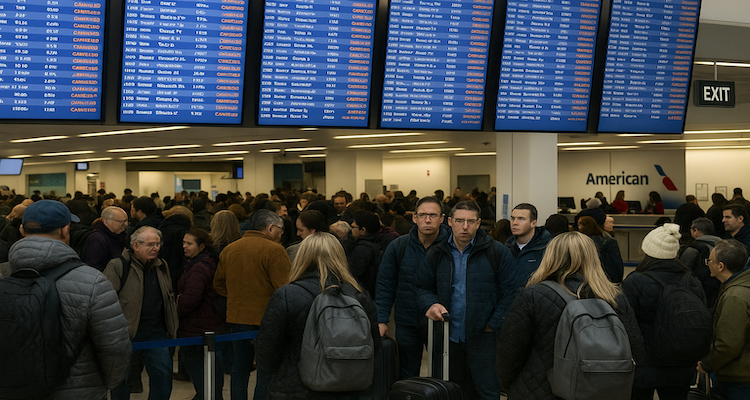Flight Chaos Deepens as U.S. Shutdown Grounds Air Travel
Air travelers across the U.S. face escalating cancellations and delays as the federal shutdown cripples the FAA, forcing airlines to slash flights and scramble for recovery.
Turbulence at Every Gate
Hope is wearing thin for millions of U.S. air travelers as the country’s longest government shutdown continues to snarl the skies. Despite optimism that Congress may soon restore federal funding, flight disruptions are worsening, leaving passengers stranded and airlines struggling to maintain schedules.
The Shutdown That Grounded America
The ongoing federal government shutdown has rippled through every layer of the aviation system. With 13,000 air traffic controllers and 50,000 TSA agents working without pay, staffing shortages have reached a critical point. The Federal Aviation Administration (FAA) has ordered airlines to scale back operations at 40 major airports, first by 4%, then 6%, and soon 10% by Friday, November 14.
Transportation Secretary Sean Duffy has warned that these cuts could soar to 15–20% if the political stalemate persists. Even if a deal is reached this week, the FAA has made no commitment on when normal flight operations will resume.
Flight Cuts, Delays, and a Nation in Waiting
Airlines nationwide have been forced into crisis management mode. The FAA’s mandatory reductions are meant to protect air safety amid staff shortages, but they’ve compounded an already chaotic travel environment. On Saturday and Sunday alone, more than 1.2 million passengers experienced disruptions, either grounded flights or hours-long delays.
Over the weekend, American Airlines reported that staffing shortfalls in air traffic control led to delays or cancellations impacting 250,000 customers. And by Sunday, airlines collectively scrapped nearly 3,000 flights and delayed more than 11,000 others.
What began as a precautionary measure has evolved into a national travel bottleneck, with ripple effects expected throughout the week.
A Tough Week Ahead
Chris Sununu, former New Hampshire governor and now head of Airlines for America, described the situation as “a tough week ahead” in a Monday interview with CNN.
“The FAA still has mandated cancellations, ramping up over the course of the week,” he said, adding that travelers should stay the course. “Keep your holiday plans. The system will be viable and resilient by Thanksgiving and Christmas.”
Despite his reassurance, Sununu acknowledged that the aviation sector is navigating uncharted turbulence. The combination of overworked, unpaid controllers and rising absenteeism has left the system fragile, even as holiday travel season looms.
When Will the FAA Lift the Cuts?
A major question remains unanswered, when will the FAA lift the flight restrictions? Secretary Duffy insists that flight capacity will only be restored once safety metrics and staffing levels return to acceptable levels.
According to FAA data, 20% to 40% of controllers at the country’s 30 busiest airports are calling out each day, leaving vast gaps in the system. Although the agency has pledged that back pay will be issued within 24 hours after the shutdown ends, officials admit that it won’t instantly bring everyone back to the control towers.
Fatigue and Financial Stress
The human toll behind the numbers is mounting. Controllers and TSA agents have been working weeks without pay, with many resorting to second jobs, driving for Uber, delivering food, or freelancing, to stay afloat.
If the shutdown drags into another week, air safety employees are set to miss yet another paycheck, further straining morale and potentially exacerbating absenteeism. The longer the shutdown lingers, the longer it will take to rebuild the fragile trust between aviation workers and federal agencies.
Thanksgiving Travel at Risk
With flight reductions expected to reach 10% by Friday, the aviation gridlock threatens to extend into one of the busiest travel periods of the year, Thanksgiving. Analysts warn that if the shutdown lasts another two weeks, the country’s holiday air travel infrastructure could face unprecedented stress.
Even after the government reopens, FAA officials caution it could take several days or even longer, for flight operations to normalize. Air traffic patterns will need to be recalibrated, controllers rescheduled, and backlog-managed before the system regains balance.
Public Frustration Mounts
Travelers across social media platforms have expressed growing anger at the lack of clarity from both government officials and airlines. Many complain about vague rebooking policies, limited customer support, and sudden cancellations that have left them stranded overnight.
While airlines have issued apologies and travel credits in some cases, industry observers say the larger issue, a paralyzed federal workforce, is out of their hands.
A System Under Pressure
The FAA’s flight cut orders remain in effect, with no timeline for reversal. Even if Congress reaches a funding deal soon, experts say the recovery process will be slow. Once controllers begin receiving pay again, it will take days to re-staff towers and rebuild the rhythm of America’s airspace network.
Until then, passengers can expect continued cancellations, extended delays, and lingering uncertainty, reminders of how deeply air travel depends on the stability of federal operations.
Clear Skies Still Out of Reach
For now, the skies over the United States remain anything but clear. The FAA’s cautious approach underscores a grim reality: restoring safety and normalcy takes time, even after the paychecks resume.
Travelers are urged to stay patient, plan flexibly, and keep expectations grounded, because the road (or rather, runway) to recovery may extend well beyond the end of the shutdown.
(Disclaimer: This article is a factual rewrite based on verified reports and official statements. It adheres to professional journalistic standards and avoids speculation.)
ALSO READ: Supreme Court Declines Kim Davis Appeal, Upholds Same-Sex Marriage Rights










